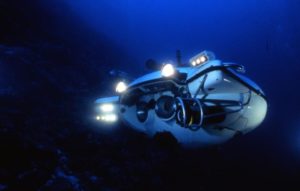 Denise was her original name, and she was the first underwater vehicle designed expressly for scientific exploration.
Denise was her original name, and she was the first underwater vehicle designed expressly for scientific exploration.Developed by Jacques-Yves Cousteau and engineer Jean Mollard at the French Center for Undersea Research, the vehicle was dubbed the SP-350 or, less formally, ” diving saucer “, because of its resemblance to the flying saucers of science fiction.
From 1959 on, the mini-submersible sailed the depths to explore unknown parts of the ocean. On board Calypso, a crane lowered the saucer into the water or lifted her up to the rear deck of the ship. With a diameter of 2.85 meters and a weight of 3.5 tons, she carries a crew of two in her steel cabin.
She can work stay as far as 350 meters down, for four or five hours.
The saucer moves just as a squid does, with an ingenious but simple jet propulsion system: water is drawn in from the outside and squirted back out through two tubes. With these jets, the saucer can move along underwater at a speed of 2 knots, or about 3.7 km/h. The two people inside are stretched out on mattresses, watching their surroundings through tilted portholes that let them come within a few centimeters of their subject.
The deeper the submersible goes, the darker the water, so three movable lights illuminate the ” world without sun ” at different angles. They can even light small objects up to 10 meters away and so reveal creatures that people have never before observed.
Onboard equipment includes two cameras, a radio and a tape recorder. The saucer is also furnished with a sampling arm, controlled from inside the cabin. Looking like a space ship, the diving saucer is perfectly suited to the environment in which it must work.
After tests, Denise became a permanent part of Calypso’s armory and, today, it has more than 1,500 dives to its credit. Denise is the oldest sibling of scientific submersibles and opened a new era of underwater research.
In 1965, technology had evolved enough to allow for the construction of two new, more advanced one-man diving saucers. These little twins were baptized Sea Fleas and can descend to 500 meters.
Saving and protecting marine life for present and future generations since 1973
©2024 The Cousteau Society.
All rights reserved.